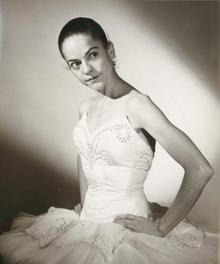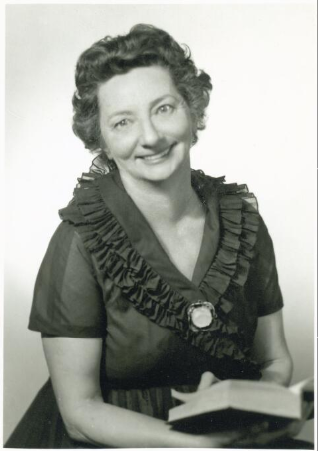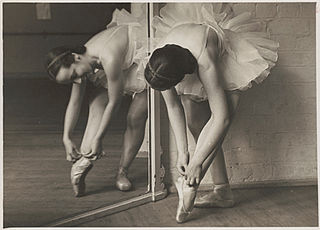The Australian Ballet (TAB) is the largest classical ballet company in Australia. It was founded by J. C. Williamson Theatres Ltd and the Australian Elizabethan Theatre Trust in 1962, with the English-born dancer, teacher, repetiteur and director Dame Peggy van Praagh as founding artistic director. Today, it is recognised as one of the world's major international ballet companies and performs upwards of 150 performances a year.
Kristian Fredrikson was a New Zealand-born Australian stage and costume designer working in ballet, opera and other performing arts. His work was acclaimed for its sumptuous, jewel-like quality, and a sensuous level of detail.

Queensland Ballet, founded in 1960 by Charles Lisner, is the premier ballet company of Queensland, Australia, and is based in Brisbane. It is one of only three full-time, professional classical ballet companies in Australia. The company has had six previous Artistic Directors, and is currently led by Leanne Benjamin.
Stephen George Page is an Aboriginal Australian choreographer, film director and former dancer. He was artistic director of the Bangarra Dance Theatre, an Indigenous Australian dance company, from 1991 until 2022. During this time he choreographed or created 33 works for the company, as well as several other major works, including segments of the opening and closing ceremonies of the Sydney Olympic Games. He was artistic director of the 2004 Adelaide Festival of the Arts, and has also done work for theatre and film.
Arnold Lionel David Haskell CBE was a British dance critic who founded the Camargo Society in 1930. With Ninette de Valois, he was influential in the development of the Royal Ballet School, later becoming the school's headmaster.
Dame Catherine Margaret Mary Scott, was a South African-born pioneering ballet dancer who found fame as a teacher, choreographer, and school administrator in Australia. As the first director of the Australian Ballet School, she is recognised as one of the founders of the strong ballet tradition of her adopted country.

Dame Margaret van Praagh was a British ballet dancer, choreographer, teacher, repetiteur, producer, advocate and director, who spent much of her later career in Australia.
Meryl Tankard is an Australian dancer and choreographer who has a wide national and international reputation.

Kathleen Ann "Kathy" Gorham was an Australian ballerina.
Paul Clement Hammond OAM was an Australian ballet dancer, teacher and choreographer.

Valentin Zeglovsky (1908–1985) was a ballet dancer with the Ballets Russes who was one of the de Basil dancers who is considered to have contributed to Australian ballet.

Hélène Kirsova was a Danish prima ballerina, choreographer and ballet teacher and is noted as the founder of the first professional ballet company in Australia. She trained in Paris with former Sergei Diaghilev ballet dancers and choreographers. She then performed in companies run by Léo Staats and Ida Rubinstein before in 1931 becoming a soloist with Les Ballets Russes de Monte Carlo, dancing for several years in Europe and North America. In 1936, as a principal dancer, she joined René Blum's Les Ballets de Monte-Carlo in which she scored a singular success in London. Later that year she joined Colonel Wassily de Basil's Monte Carlo Russian Ballet as prima ballerina on an extensive tour of Australia and New Zealand where she was fêted by critics and audiences. She remained in Australia, started a ballet school in Sydney, and in 1941 formed the Kirsova Ballet. Despite wartime restrictions she directed the company for several years before retiring in 1948. She has been described as the "Godmother" of Australian ballet.

Roma Jean Egan was a child actress on Australian television, and an Australian ballet dancer and teacher. She was notably a senior soloist for The Australian Ballet, and variously performed for the Queensland Ballet, Basel Ballet, Ballet Victoria and Royal New Zealand Ballet.

Tamara Tchinarova, also known as Tamara Finch, was a Romanian-born émigré Russian and French ballerina who contributed significantly to the development of Australian dance companies and was a Russian/English interpreter for touring ballet companies. She was a dance writer and author, as Tamara Finch, of a number of non-fiction books. She was the first wife of actor Peter Finch.
Anne Elder was an Australian ballet dancer and poet.
The Display is an Australian ballet produced and choreographed by Robert Helpmann to music by Malcolm Williamson for The Australian Ballet. Described as the first wholly Australian ballet, The Display had an all-Australian cast, with sets and costumes by artist Sidney Nolan. The work had its world premiere on 14 March 1964 at Her Majesty's Theatre in Adelaide as part of the Adelaide Festival of Arts.
Loudon Sainthill was an Australian artist and stage and costume designer. He worked predominantly in the United Kingdom, where he died. His early designs were described as 'opulent', 'sumptuous' and 'exuberantly splendid', but there was also a 'special quality of enchantment, mixed so often with a haunting sadness'.

Xenia Nikolaeva Smirnova Krüger Borovansky was a Russian-born dancer and choreographer, based in Australia after 1939. She was principal teacher at the Melbourne Academy of Russian Ballet, and active in running the Borovansky Ballet.

Rachel Cameron was an Australian ballet dancer and teacher. She was one of the leading dancers in early Australian ballet in the 1940s, performing with the Borovansky and Kirsova ballet companies, and was one of the first ballet dancers in Australia to reach the rank of principal. After emigrating to Great Britain she was an inspirational educator of ballet teachers at the Royal Academy of Dance in London for over forty years. In 2010, she received the Royal Academy of Dance's prestigious Queen Elizabeth II Coronation Award in recognition of her outstanding services to ballet.
The Kirsova Ballet was the first professional Australian ballet company. It was founded by prima ballerina Hélène Kirsova in 1941. Initially the leading performers were dancers who had stayed in Australia following the 1938/1939 tour of the Covent Garden Russian Ballet, but they were supported by talented young Australian dancers promoted from Kirsova's ballet school in Sydney. These local performers soon led the troupe and appeared in several seasons in Sydney, Melbourne, Adelaide and Brisbane. The company also supported Australian composers, musicians, artists and designers in producing new ballets choreographed by Kirsova. Struggling under wartime restrictions, unable to tour abroad, and later suffering creative differences with the country's main theatre owners, the company's prominence was brief. It closed in 1945 having been the pioneer of a genuine Australian ballet tradition. Its influence on Australian ballet was significant.









